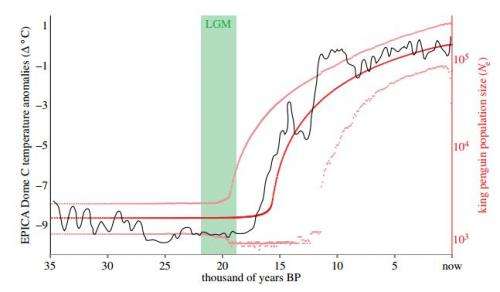June 11, 2014 report
Researchers use genome analysis to understand how King Penguins came to breed on Crozet Islands

(Phys.org) —A team made up of researchers from several European countries has used DNA analysis to better understand how it was that King Penguins came to breed on the Crozet Islands. In their paper published in Proceedings of the Royal Society B, the team describes how they managed to gather DNA samples from King Penguins without disturbing them and how analyzing what they found helped to reveal how the penguins came to colonize the Crozet Islands.
King Penguins are the second largest penguins and live and breed on islands north of Antarctica—most predominantly the Crozet Islands in the southern Indian Ocean. In this new effort the researchers sought to learn more about the history of the penguins on the islands, which they hoped would help in discovering what might happen to them as global warming causes changes to their environment.
The research team ventured to one of their island breeding grounds and snuck chicks out from under their watchful parents, replacing them temporarily with fake eggs. In addition to taking physical measurements, blood samples were taken from each of the chicks before they were returned to their parents, apparently none the worse for the wear. The team then analyzed over 65,000 snippets of DNA obtained from eight of the chicks. Their genomes revealed that the penguins had existed as a small group until about 15,000 years ago—after that, their population soared. This time period, the researchers note, coincides with the end of the last ice age.
As the ice abated, conditions for the penguins became ideal. When taking care of their young, adults swim 250 miles offshore to what is known as the polar front—a place where cold polar water collides with warm tropical waters. There the penguins fill up on lanternfishes, returning every three to five days to feed their chicks. In the winter, the adults swim even farther, traveling over 600 miles to find food.
Unfortunately, for the penguins, as the planet heats up, some climate models suggest it's likely the site of the polar front will move farther south, perhaps taking food out of reach of adults who need to return to breeding grounds to feed their offspring. Thus, the fate of King Penguins, could very well be in doubt.
More information: Paper: rspb.royalsocietypublishing.or … .1098/rspb.2014.0528
Journal information: Proceedings of the Royal Society B
© 2014 Phys.org


















